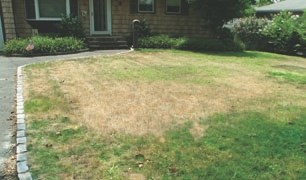If you don't decide to replace your lawn with artificial turf or tear the whole thing out and learn the benefits of xeriscaping, there are some things you can do to rehabilitate a shabby patch of grass that's lost its curb appeal or a backyard that's been repurposed as a toilet for the family pet.
Pets
The family dog can leave a yard in miserable shape. The material it lays down on the lawn is high in salt. Unless you're prepared to douse the patch where Sparky has done his business every time he goes, you're going to see those burnt patches.
"The old solution through dilution approach," Jim Hole of Hole's Greenhouses calls it.
Hole has seen some pretty odd efforts to reduce the salt content of domestic animals' waste products.
"I see it on the Internet, people talking about changing the dog's diet, feeding it different things. Adding a little vinegar to their water. Really crazy stuff. They believe it's the PH of the soil that's creating the problem, but the big issue is that there's a lot of salt in there. And you get ammonium levels that can be outright toxic to roots. And soil microbes don't like that either."
One fellow Hole knows deals with the damaged lawn by spot sodding the affected ground. Some people will reseed selectively, and still others will live with the blotchy effect. By summer's end, if the lawn is in good shape otherwise, the natural growth pattern will take care of the problem itself.
Fertilizer
The ground needs nutrients to support growth, but not all fertilizers are equal. Fertilizer is a mix of nitrogen, phosphorous and potassium (NPK) in various proportions.
The first number should always be the highest. A lawn doesn't need as much phosphate as many mixtures contain.
Soil
After sunlight, most plants need good soil. A good top dressing of rich soil will go a long way toward rehabilitating a languishing lawn.
"If the lawn has clay and just an inch or two of soil, you'll be fighting that crappy lawn forever," Hole says.
"If you're going to the trouble of trying to rejuvenate your lawn and you have the opportunity to put some good soil in there, then do it. It's worth the investment."
"If you've got a marginal lawn, put some top dressing of the loaming material over top of the grass. It works its way in and breaks down some of the thatch. It builds the soil from the top down. It's quite an effective way of doing it if you don't want to go to the trouble of ripping the lawn out and starting from scratch."
Aeration
Hole recommends aeration as a way of breathing new life into compacted soil.
"If the ground feels hard, aeration is a very important thing to do. It allows the oxygen, the water and the nutrients to get down to the root zone."
Walking on the lawn with golf shoes will not aerate the soil, he jokes. It just shifts the compaction.
"You've got to physically take cores out, and then you can smash the cores up. Don't remove them from your lawn. Grind them up and let it go back down again. That provides enormous benefit to lawn grass for sure."
He warns that rental coring machines can spread the fairy ring fungus, so clean it off before use.
Trees
A big tree on a lawn many be beautiful, but it will inevitably compete for water and cast shade.
No species of tree is necessarily worse for the lawn than another. Hole points out that evergreens, with their shedding needles, do not affect a lawn's PH levels, which should be in the high six to low seven range on a 14-point scale. The myth is that spruce needles raise the acidity of the soil, disturbing the PH balance. They don't.
"A little knowledge is a dangerous thing. People studied PH in high school. Somebody repeats the term PH, and everybody buys into it. It's not an issue."
Spruce needles can affect lawn health, though.
"It's not about acidity. It's just about the fact that the needles kind of act as a barrier. You've got dryness, you've got shade, and you've got these additional needles that are tougher on the plants because they tend to cover them over."
Sunlight
"In a perfect world, people would have a gorgeous spruce and then gorgeous grass growing up to the base, but again, there's no substitute for sunlight. Let's face it, trees that are creating a lot of shade during the growing season and are going to have an impact on the grass."
Chopping it down for the sake of the lawn should be a radical last choice, he argues.
So a healthy lawn requires a good maintenance program with several elements. Done right, even a pathetic lawn can be perked up.




